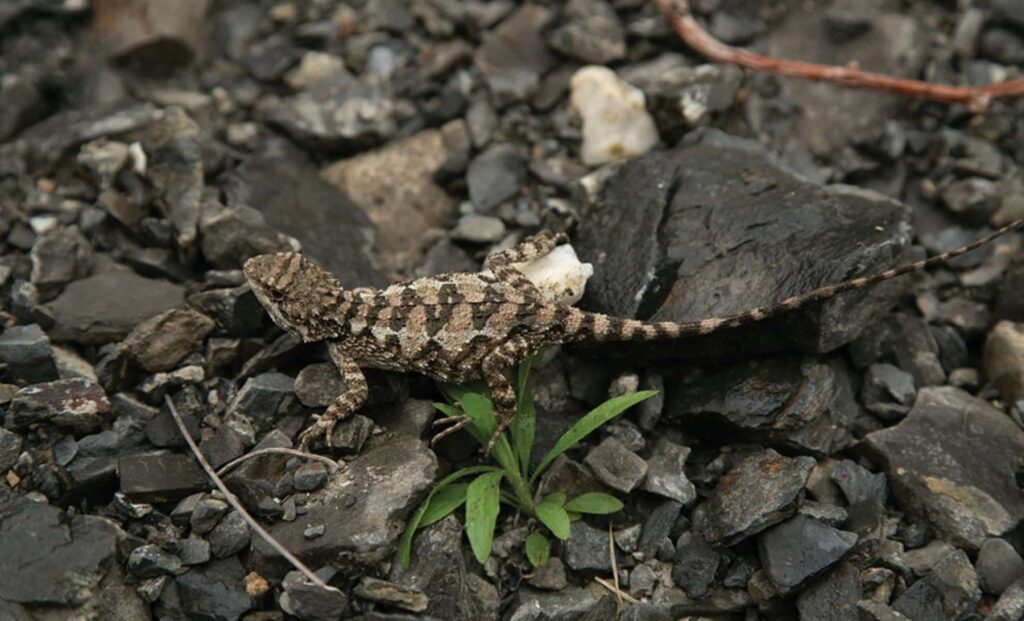The lizard, measuring just 2.5 to 2.8 inches from snout to vent, was uncovered by a team of researchers from the Chengdu Institute of Biology, Chinese Academy of Sciences. Its distinctive appearance and genetic makeup have set it apart from similar species in the Diploderma genus. This find brings the total number of Diploderma species in China to 47, highlighting the remarkable diversity of lizards in the country’s mountainous regions. However, the discovery is also a stark reminder of the threats posed by human development, as this species faces potential habitat loss due to a nearby hydropower project.
Unique Characteristics of Diploderma bifluviale
One of the most notable features of Diploderma bifluviale is its jagged, lemon-colored stripes, a rare trait among its relatives. Males of this species are particularly striking, with the serrated stripes running along their backs. In addition to this unique coloration, the lizard has a concealed eardrum and no throat patch, further distinguishing it from other Diploderma species. It also has a wheat-colored tongue, short limbs, and a compact body. According to the study published in ZooKeys, its fourth toe extends to the area near the ear opening, a characteristic that is shared with no other species in the region.
Researchers utilized a variety of methods, including DNA analysis of the mitochondrial ND2 gene, to confirm the species’ distinct genetic identity. The genetic divergence of Diploderma bifluviale from its close relatives, such as Diploderma danbaense and Diploderma flaviceps, was clear, strengthening the argument for its classification as a new species. Morphometric analysis using principal component analysis (PCA) also supported these findings, providing strong evidence of its uniqueness.

Habitat and Distribution
Diploderma bifluviale inhabits the semi-arid shrublands of the upper Dadu River valley, an area that has long been underexplored. The valley sits between 7,200 and 8,300 feet in elevation and is known for its extreme temperature fluctuations and rugged terrain. These conditions make it a hotspot for endemic species, many of which are adapted to the harsh, dry environment. Unlike many of its relatives, which thrive in wetter climates, Diploderma bifluviale has adapted to this arid landscape, with its rough body scales and short tail likely helping it conserve heat during the cooler nights at high altitudes.
The lizard’s population is thought to be small and patchy, as only a handful of individuals were observed during the extensive field surveys conducted between 2018 and 2024. This suggests that the species could be highly sensitive to disturbances in its environment, which is already at risk. The Dadu River valley, described as a biodiversity hotspot, has also been targeted for major development projects, such as the Shuangjiangkou hydropower project, which could alter the flow of the river and threaten the lizard’s habitat.


Environmental Threats and Conservation Concerns
The discovery of Diploderma bifluviale is significant not only for its scientific value but also for its conservation implications. According to lead researcher Fengjing Liu, the species’ habitat is fragile and could be at risk from human activities. The dam’s construction could lead to changes in the river’s flow and the surrounding environment, putting pressure on the species’ already limited population.
The researchers are calling for careful monitoring of the species and its habitat, urging for mitigation strategies to protect it from the consequences of development. Liu also emphasized the importance of preserving biodiversity in the upper Dadu River valley, an area that has long been understudied. Long-term ecological monitoring will be essential to ensure that Diploderma bifluviale is not pushed to the brink of extinction by the ongoing changes to its environment.

